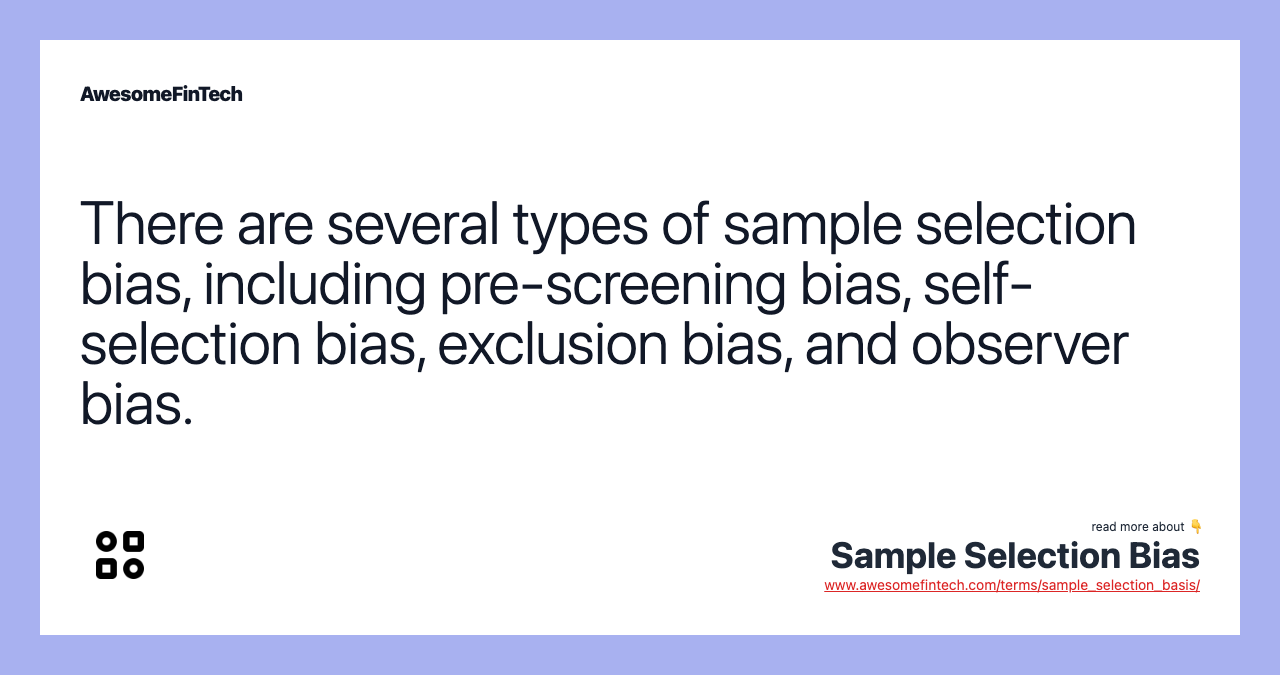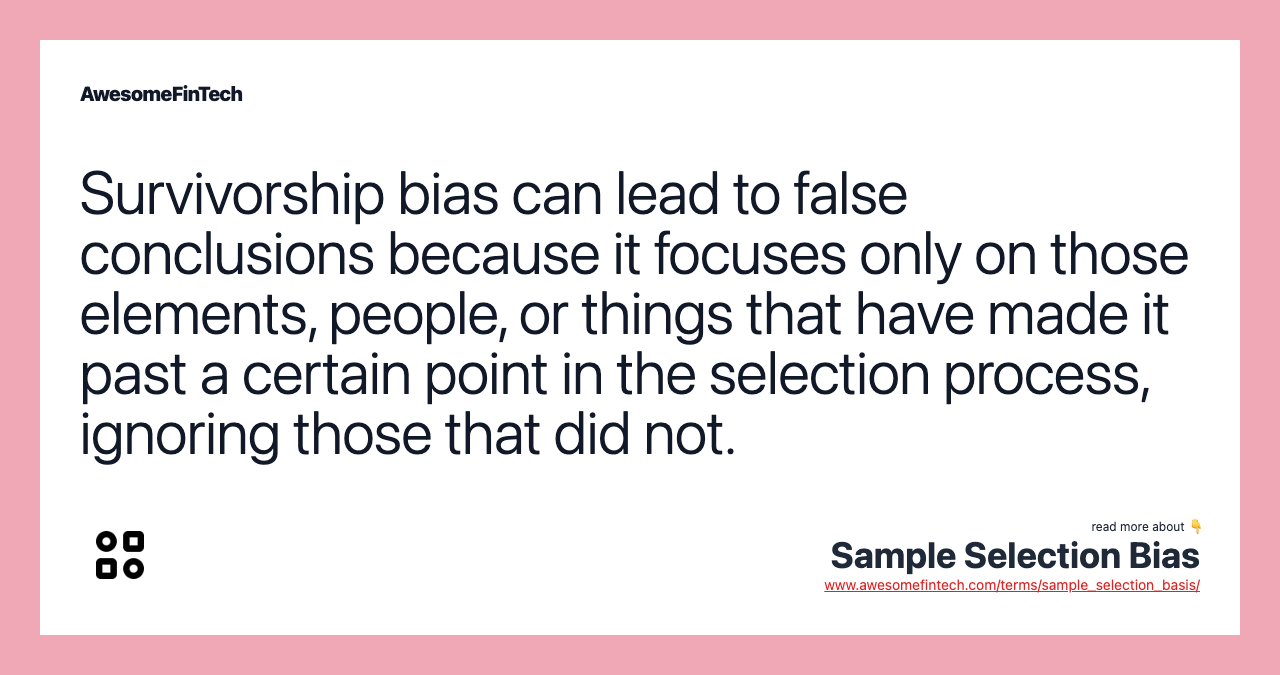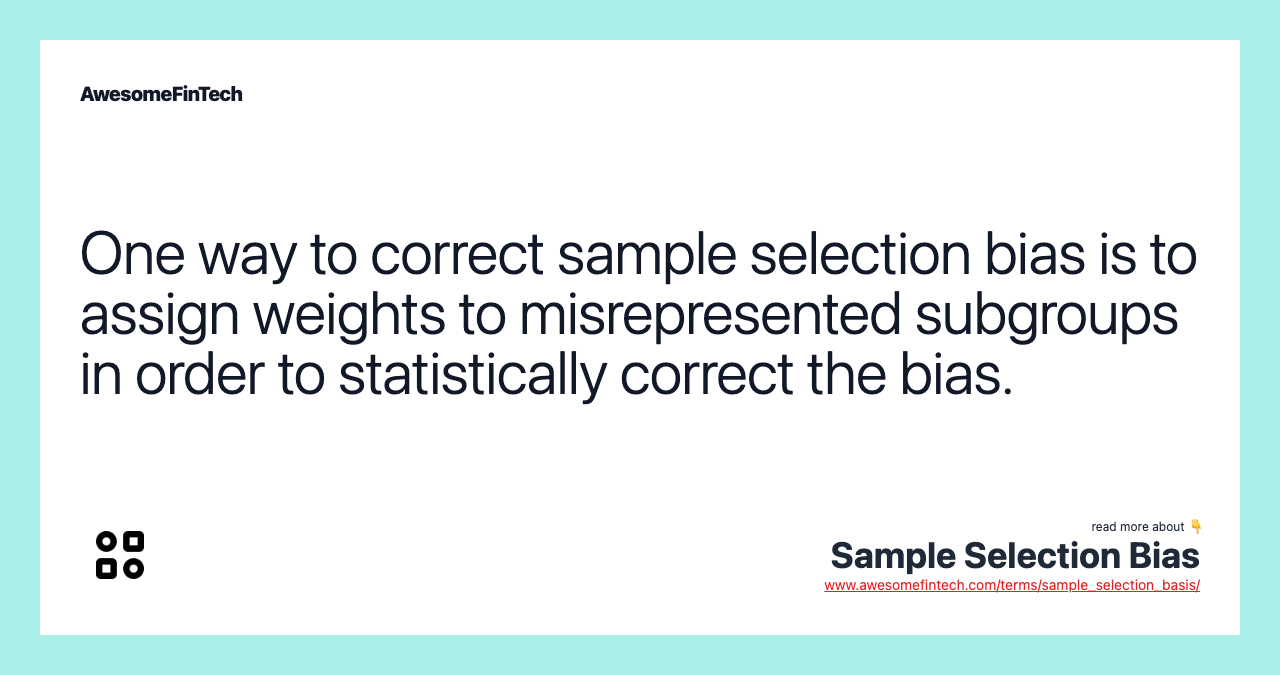Sample Selection Bias
Sample selection bias is a type of bias caused by choosing non-random data for statistical analysis. There are several types of sample selection bias, including pre-screening bias, self-selection bias, exclusion bias, and observer bias. Self-selection bias — also known as volunteer response bias — occurs when the study organizers allow participants to self-select or volunteer to participate. One way to correct sample selection bias is to assign weights to misrepresented subgroups in order to statistically correct the bias. Sample selection bias is a type of bias caused by choosing non-random data for statistical analysis.

What Is Sample Selection Bias?
Sample selection bias is a type of bias caused by choosing non-random data for statistical analysis. The bias exists due to a flaw in the sample selection process, where a subset of the data is systematically excluded due to a particular attribute. The exclusion of the subset can influence the statistical significance of the test, and it can bias the estimates of parameters of the statistical model.





Understanding Sample Selection Bias
Survivorship bias is a common type of sample selection bias. This type of bias ignores those subjects that did not make it past a certain point in the selection process and only focuses on the subjects that "survived." This can lead to false conclusions.
For example, when backtesting an investment strategy on a large group of stocks, it may be convenient to look for securities that have data for the entire sample period. If we were going to test the strategy against 15 years worth of stock data, we might be inclined to look for stocks that have complete information for the entire 15-year period.
However, eliminating a stock that stopped trading, or shortly left the market, would input a bias in our data sample. Since we only include stocks that lasted the 15-year period, our final results would be flawed, as these performed well enough to survive the market.
Types of Sample Selection Bias
In addition to survivorship bias, there are several other types of sample selection bias.
Advertising or Pre-Screening Bias
This occurs when the way participants are pre-screened in a study introduces bias. For example, the language researchers use to advertise for participants can itself introduce bias into the study simply by discouraging or encouraging certain groups of people from volunteering to participate.
Self-Selection Bias
Self-selection bias — also known as volunteer response bias — occurs when the study organizers allow participants to self-select or volunteer to participate. The study organizers relinquish control over who participates to those who decide to volunteer. This may lead people with specific characteristics or opinions to volunteer for a study and thus skew the results.
Exclusion and Undercoverage Bias
Exclusion bias occurs when specific members of a population are excluded from participating in a study. Undercoverage bias occurs when study organizers create a study that does not adequately represent some members of the population.
Example of Sample Selection Bias
Hedge fund performance indexes are one example of sample selection bias subject to survivorship bias. Because hedge funds that don’t survive stop reporting their performance to index aggregators, resulting indices are naturally tilted to funds and strategies that remain, hence “survive.” This can be an issue with popular mutual fund reporting services as well. Analysts can adjust to take account of these biases but may introduce new biases in the process.
Observer bias happens when researchers project their own beliefs or expectations to participants of a study, thereby skewing the results of the study. This sometimes occurs in conjunction with cherry-picking, which is when researchers focus primarily on statistics that support their hypothesis.
Special Considerations
Researchers and study organizers have the responsibility to ensure the results of their studies are accurate, relevant, and do not incorporate any type of bias that could lead to flawed conclusions. One way to do this is to structure the study based on a method that supports a random sample selection process.
While in theory, this may seem simple enough, the reality is that the researcher will need to be vigilant in their efforts to prevent sample selection bias. Additionally, the study organizer may be faced with restrictions beyond their control that make it challenging to realize a random sample. For example, there may be a lack of participants or inadequate funding for the project.
To make sure the sample being studied is random, the researcher should identify the various subgroups within the population. They should then analyze the sample to determine if these subgroups are adequately represented in the study.
In some cases, the researcher may find that certain subgroups are either overrepresented or underrepresented in their study. At this point, the researcher can implement bias correction methods. One method is to assign weights to the misrepresented subgroups in order to statistically correct the bias. This weighted average takes into account the proportional relevance of each subgroup and can lead to results that more accurately reflect the study population's actual demographics.
Related terms:
Backtesting
Backtesting evaluates the effectiveness of a trading strategy by running it against historical data to see how it would have fared. read more
Bias
Bias is an irrational assumption or belief that warps the ability to make a decision based on facts and evidence. read more
Cherry Picking
Cherry picking refers to the act of choosing top securities for investment from research that generally overlooks large amounts of data or disregards broad market metrics. read more
Hedge Fund
A hedge fund is an actively managed investment pool whose managers may use risky or esoteric investment choices in search of outsized returns. read more
Population
Population may refer to the number of people living in a region or a pool from which a statistical sample is taken. See our population definition here. read more
Representative Sample
A representative sample is used in statistical analysis and is a subset of a population that reflects the characteristics of the entire population. read more
Sample Size Neglect Defined
Sample Size Neglect is a cognitive bias whereby people reach false conclusions by failing to consider the sample size in question. read more
Sample
A sample is a smaller, manageable version of a larger group. Samples are used in statistical testing when population sizes are too large. read more
Sampling Error
A sampling error is a statistical error that occurs when a sample does not represent the entire population. See how to avoid sampling errors in data analysis. read more
Simple Random Sample
A simple random sample is a subset of a statistical population in which each member of the subset has an equal probability of being chosen. read more